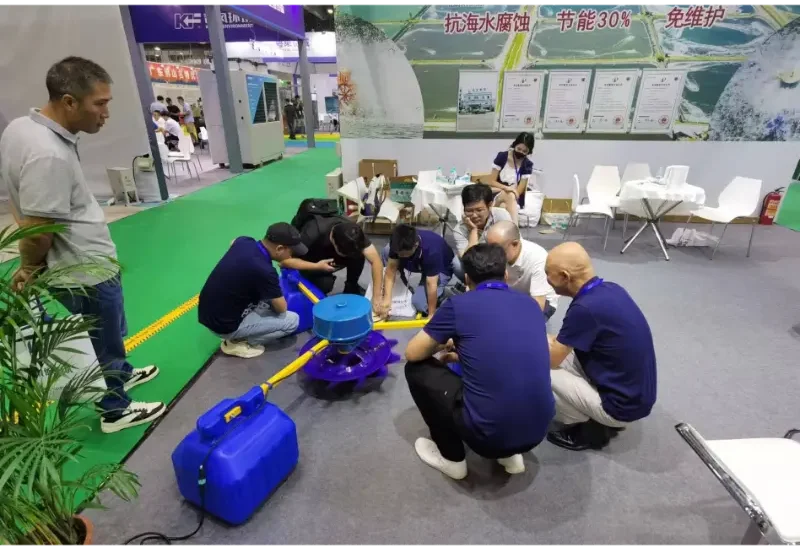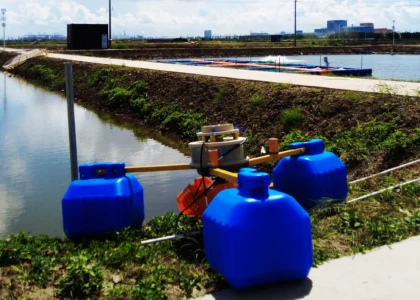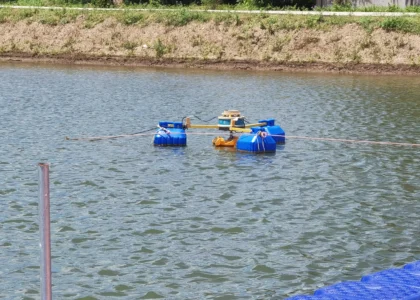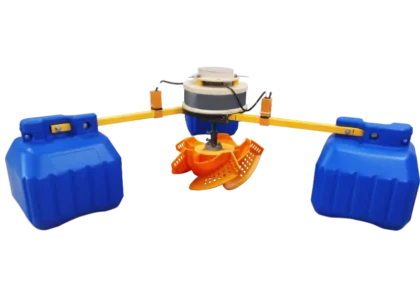1. Increase oxygen content
Aerators accelerate the circulation of water and continuously replenish oxygen to the water, effectively promoting the growth of fish. Adequate oxygen can ensure the normal metabolism of fish and accelerate their growth. At the same time, a high dissolved oxygen environment can inhibit the growth of bacteria and reduce the occurrence of pests and diseases. For example, when the dissolved oxygen content in the water is kept within a reasonable range, the growth and reproduction of harmful bacteria is inhibited, reducing the risk of fish disease. In addition, the role of aerators is also reflected in providing a source of feed for fish. The flow of water promotes the rapid reproduction of plankton, which becomes a natural bait for fish, enriching the food source of fish and further promoting the growth and development of fish.
2. Equipped with suitable aerator
When choosing an aerator, you need to consider multiple factors, such as water source, breeding, cost-effectiveness, water inlet and outlet, etc. If the water source is abundant and the water quality is good, such as a large water inlet and flowing, the number of aerators can be appropriately reduced. Generally speaking, in a breeding pond with sufficient and flowing water, the dissolved oxygen content in the water is relatively high, which can reduce the number of aerators and the frequency of use, thereby reducing costs and increasing benefits.
In terms of breeding factors, aerators should be equipped according to the density of fish. When the breeding density is high, the fish's demand for oxygen increases, and more aerators are needed to meet the oxygen content in the water. According to statistics, for every increase in a certain percentage of breeding density, the number and power of aerators required will also increase accordingly. For example, when the breeding density doubles, a certain number of aerators may need to be added, and the power consumed will also increase accordingly.
Cost-effectiveness is also an important consideration. At present, the use of aerators in aquaculture can increase production and benefits, but it also increases costs. If the aerator has a high cost-effectiveness, that is, it has a good oxygenation effect and relatively low energy consumption, then more aerators can be equipped; otherwise, the number of aerators can be reduced to save production costs.
Inlet and outlet factors will also affect the configuration of aerators. If the water source is from the ditch, the water intake and outlet volume are almost equal, and the dissolved oxygen content in the water body can be increased during the flow, then the number of aerators can be reduced or eliminated. If water is pumped into the aquaculture pond, the water flow is small, and the configuration of aerators needs to be increased.
(III) Different situations for correct use of aerators
- The high temperature weather starts at noon on sunny days, promoting water convection and improving the ecological environment:At noon on a sunny day in hot weather, especially in aquaculture ponds with thick water and vigorous phytoplankton reproduction, it is very important to turn on the aerator. At this time, phytoplankton performs a large amount of photosynthesis, making the oxygen content in the surface layer of the aquaculture pond sufficient or even saturated, but the oxygen content in the bottom layer of the water is relatively low. After turning on the aerator, the water body convects up and down, making the oxygen content in the entire aquaculture pond uniform and sufficient. At the same time, the lower layer of water convects to the upper layer, and after being exposed to sunlight, it can kill bacteria in the water, volatilize harmful substances into the air, improve the ecological environment of the aquaculture pond, purify the water body, and thus increase production and benefits.
- Thunderstorms start in the morning to prevent convection between upper and lower layers of water causing floating heads: During thunderstorms, the water in the breeding pond flows up and down rapidly, and the oxygen content decreases rapidly. During the day, the sun is strong and the temperature is high. When thunderstorms occur in the evening, a large amount of rainwater enters the breeding pond. Due to the low temperature of the rainwater, the surface water temperature of the breeding pond drops rapidly, and the specific gravity increases, causing the fish to sink. The lower layer of water has a high temperature and a low specific gravity, so it floats, causing convection between the upper and lower layers of water. Although the oxygen content is temporarily increased, it is also consumed quickly, which can easily cause the fish to float. Therefore, it is necessary to turn on the aerator as early as possible and more often to reduce the floating phenomenon.
- The continuous rainy weather is turned on at midnight to increase dissolved oxygen and relieve floating head: When it rains continuously, there is less sunlight, less wind, lower air pressure, and greater oxygen consumption. The photosynthesis of phytoplankton is weak, and the dissolved oxygen content in the water is insufficient. At the same time, continuous rain will also cause an increase in Daphnia in the breeding pond, which will eat most of the phytoplankton in the water, resulting in a passive reduction in photosynthesis and insufficient oxygen supply. Turning on the machine in the middle of the night can increase dissolved oxygen and relieve floating heads. At this time, the machine should generally be turned on until sunrise to increase the oxygen content in the water and ensure that the growth of fish is not affected.
- Open more often when hypoxia is serious to prevent "pond flooding" accidents:Severe hypoxia usually occurs in the summer dry season. On the one hand, long-term sunlight exposure raises the water temperature in the breeding pond, and a large amount of organic matter in the water increases, resulting in relatively low water transparency, a large difference in photosynthesis between the upper and lower water bodies, and severe hypoxia in the lower water body. On the other hand, fish have a strong appetite, and a large amount of feed causes the water quality to be thick, and the fish carrying capacity in the water increases, which may cause the pond fish to float seriously. At this time, it is necessary to regularly inject new water into the pond to improve the ecological environment for fish survival, and to turn on the aerator more often before the fish float to prevent the occurrence of "pond flooding" accidents.
- It is not turned on when feeding and in the evening, and it is not turned on at noon on rainy days. The opening time can be flexibly controlled.:When feeding, turning on the aerator will easily rotate the feed to the center of the breeding pond, causing the feed and excrement to mix and pile up together, making it difficult for fish to eat, resulting in feed waste. In the evening, although the photosynthesis of phytoplankton in the fish pond is about to stop, the dissolved oxygen in the water is not yet tight. If the aerator is turned on at this time, it will not only have little effect, but will cause the upper and lower water layers of the pond to convect earlier, mix vertically in advance, increase the oxygen-consuming water layer, reduce the dissolved oxygen content of the upper water layer and cannot be replenished, and the dissolved oxygen in the lower water layer will be quickly consumed, forming an oxygen debt, so that the dissolved oxygen content in the water reaches the lowest peak at dawn, which is very likely to cause fish to float. On rainy days, there is insufficient light at noon, the photosynthesis of phytoplankton is weak, the dissolved oxygen content in the surface water layer is not oversaturated, and the thermal stratification of the pond water is not obvious. Turning on the aerator at this time not only reduces the oxygen-generating function of the upper phytoplankton, but also accelerates the oxygen consumption rate of the lower layer, which is very likely to cause fish to float. The aerator is usually turned on for 1-3 hours, and it should be flexibly controlled according to the actual situation: long time on hot days, short time on cool days; long time at night, short time at noon; long time when wind is low, short time when wind is high; large amount of fertilizer applied to the pond, long time on; small amount of fertilizer applied to the pond, short time on; in addition, the start time should be flexibly controlled according to factors such as the density of fish stocked in the pond and fish carrying capacity.








